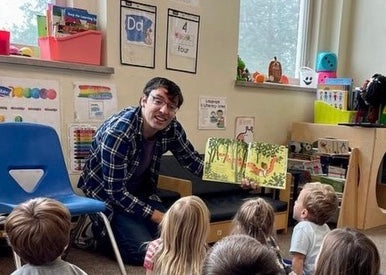The Little Fortunes game focuses on pregnancy myths that explain where baby boys and baby girls come from. Here at So Dreamy Media, however, our love for historic folklore and old wives’ tales does not stop with pregnancy myths and gender predictions. While perusing the children’s books on my kids’ shelves during story-time, I have been exposed to other wonderful legends that go far beyond how baby boys and baby girls come to be.
The subgenre of folk tales and origin myths that explain why something is a certain way or how something came to be are called pourqoui stories. Even if you are unfamiliar with the term pourqoui, you would no doubt be familiar with some of the tales considered pourqoui stories--think animal origin myths like “How the Camel Got its Hump” or “How the Elephant Got its Trunk.”
See below for what pourquoi titles are on my kids’ bookshelves!
Ahuli’i, Gabrielle. “Māui Hooks the Islands.” Hawaiian Legends for Little Ones. Mutual Publishing, LLC. 2016.
Like many families, my kids absolutely love Disney’s Moana. And while the movie has lovely lessons on perseverance, self-belief, and community values, the character Maui (and Māui the mythological demigod of Polynesian folklore that the Disney character is loosely based on) is also a treasure trove of pourqoui stories that answer how things came to be in Hawaii, New Zealand, and across Polynesia.
Full discloser: We’ve seen Moana so many times that my wife can perform his rap interlude in the song “You’re Welcome” from memory, reciting many of the Polynesian origin myths that feature Maui in a starring role. “I could explain every natural phenomenon, the tide, the grass, the ground…sprouted a tree, now you got coconuts…I make everything happen.”
There are plenty of children stories about Māui and the legends concerning the origins of Polynesia; which is great as it gets our family opening books and away from the T.V. screen. Our favorite Māui stories are part of Gabrielle Ahuli’i’s children’s book series Hawaiian Legends for Little Ones.
In this series, Ahuli’i introduces kids to some of Hawaii’s best-known folklore, much of which could be considered pourqoui stories. For example, in Māui Hooks the Islands, Ahuli’i lays out how the Hawaiian Islands came to be, relaying the story of a young Māui that uses his strength and magical hook to “fish” the islands out of the Pacific Ocean. In another book titled Māui Slows the Sun, Ahuli’i explains why daylight lasts a solid twelve hours (depending on the season of the year), giving folks plenty of time to finish their chores before darkness sets.

Origin myths and pourquoi stories that place Māui in the starring role go beyond just the Hawaiian Islands. Similar tales can be found in New Zealand, where it is said that he also “fished” out the North Island of Te-Ika-a-Māui with his magical hook. Other New Zealand folklore explains the origin of fire and how Māui’s trickster personality ultimately led the god Mahuika to “plant” her fire in the Mahoe, the Tōtara, the Patete, the Pukatea, and the Kaikōmako trees. Based on this origin tale, the reason why dry sticks are a critical ingredient of fire is because the wood has “held onto” the fire of Mahuika. Rubbing sticks together forms a friction, and if you rub long enough and hard enough, it will “bring” the fire from Mahuika’s volcanic cave to the surface of the world to be used by humans.
Bruchac, Joseph. The First Strawberries: A Cherokee Story. Puffin Books. 1998
Similar to our love for Disney movies, our family also loves Dolly Parton’s Imagination Library! These next two pourquoi stories come from Ms. Parton’s amazing book gifting program. If you’re a young family who is not familiar with Dolly’s Imagination Library, I highly recommend checking it out and signing up your little ones to be mailed a new, free book every month up until they are five years old.
The First Strawberries is a pourquoi story that explains how strawberries came into existence. In this Cherokee legend, the world’s first man insults the world’s first woman (and his partner). The woman, being justifiably angry, leaves the man and briskly walks out and away from their home. The man, regretting his behavior, follows her to apologize, but the woman is too far ahead to catch up. The sun intervenes to slow the woman down by using its sunrays to grow beautiful and distracting berries in the middle of her path. None of the sun’s attempts work until its sunrays bring strawberries into the world. A strawberry patch successfully catches the woman’s eye, slowing her down long enough for the man to catch up and apologize.
While strawberries get most of the love in this book, the book also serves as pourquoi story for other berries. In this tale, we also learn the origins of raspberries, blueberries, and blackberries--all created by the sun in its first three unsuccessful attempts to attract the woman’s attention.

Bruchac, Joseph and James Bruchac. Rabbit’s Snow Dance. Dial Books. 2012.
I apologize for doubling up on the same author as The First Strawberries, but to emphasis my family’s fondness for Dolly Parton’s Imagination Library, here’s another pourquoi story from the book gifting program.
Rabbit’s Snow Dance is an Iroquois folktale that explains how the rabbit specie came to have a short tail. In this legend, rabbits originally had long, flowing tails. A snow loving and impatient rabbit, however, changed the specie’s course of history by conjuring a snow storm during the summer months. The snow became so deep that it reached the tops of the trees, and it is in such a tree that the Rabbit decided to sleep for the night. The summer heat melted all the snow while the Rabbit slept, and when the Rabbit woke up and rolled off one of the tree branches, there was no longer a soft blanket of snow to catch its fall. The rabbit hit tree branch after tree branch while falling, and each tree branch caught a little piece of its tail until all that was left was a small, round, cotton ball.
The story also doubles up as a pourquoi story for the Cottonwood tree. Yup; all that springtime cotton-like seeds found in a populus deltoides are really just little pieces of the Rabbit’s once long and luscious tail.

A side note: there seems to be some problematic history regarding the term “pourquoi stories” and its predecessor phrase “just so stories.” The phrase is often described as a pejorative term and as a subtle insult against theories of evolution used by those who favor creationism. Sources suggest that there’s an implicit criticism in calling something a “just so story” as they often focus on the fanciful and unprovable.
The Little Fortunes game prides itself for addressing the problematic and often sexist history of predicting a baby’s sex. It is in this same fashion that we give visibility to the problematic legacy of “just so stories.”

